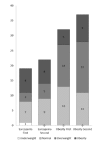SARCOPENIA, OBESITY AND SARCOPENIC OBESITY IN LIVER TRANSPLANTATION: A BODY COMPOSITION PROSPECTIVE STUDY
- PMID: 31038559
- PMCID: PMC6488274
- DOI: 10.1590/0102-672020190001e1434
SARCOPENIA, OBESITY AND SARCOPENIC OBESITY IN LIVER TRANSPLANTATION: A BODY COMPOSITION PROSPECTIVE STUDY
Abstract
Background: Sarcopenia is prevalent before liver transplantation, and it is considered to be a risk factor for morbidity/mortality. After liver transplantation, some authors suggest that sarcopenia remains, and as patients gain weight as fat, they reach sarcopenic obesity status.
Aim: Prospectively to assess changes in body composition, prevalence and associated factors with respect to sarcopenia, obesity and sarcopenic obesity after transplantation.
Methods: Patients were evaluated at two different times for body composition, 4.0±3.2y and 7.6±3.1y after transplantation. Body composition data were obtained using bioelectrical impedance. The fat-free mass index and fat mass index were calculated, and the patients were classified into the following categories: sarcopenic; obesity; sarcopenic obesity.
Results: A total of 100 patients were evaluated (52.6±13.3years; 57.0% male). The fat-free mass index decreased (17.9±2.5 to 17.5±3.5 kg/m2), fat mass index increased (8.5±3.5 to 9.0±4.0; p<0.05), prevalence of sarcopenia (19.0 to 22.0%), obesity (32.0 to 37.0%) and sarcopenic obesity (0 to 2.0%) also increased, although not significantly. The female gender was associated with sarcopenia.
Conclusion: The fat increased over the years after surgery and the lean mass decreased, although not significantly. Sarcopenia and obesity were present after transplantation; however, sarcopenic obesity was not a reality observed in these patients.
Racional:: A sarcopenia é prevalente antes do transplante de fígado e é considerada fator de risco para morbidade/mortalidade desses pacientes. Após o transplante hepático, alguns autores sugerem que a sarcopenia permanece, e os pacientes ganham peso na forma de gordura, atingindo o status de obesidade sarcopênica.
Objetivo:: Avaliar prospectivamente as mudanças na composição corporal, prevalência e fatores associados em relação à sarcopenia, obesidade e obesidade sarcopênica após o transplante.
Métodos:: Os pacientes foram avaliados em dois momentos diferentes para composição corporal, 4,0±3,2 e 7,6±3,1 anos e após o transplante. Os dados da composição corporal foram obtidos por meio de bioimpedância elétrica. O índice de massa livre de gordura e o índice de massa gorda foram calculados, e os pacientes foram classificados nas seguintes categorias: sarcopênico; obesidade; obesidade sarcopênica.
Resultados:: Foram avaliados 100 pacientes (52,6±13,3 anos; 57,0% homens). A prevalência de sarcopenia (19,0% para 22,0%), obesidade (32,0% para 37,0%) e índice de massa livre de gordura (17,9±2,5 para 17,5±3,5 kg/m2), índice de massa gorda aumentou (8,5±3,5 para 9,0±4,0 kg/m2), e obesidade sarcopênica (0 para 2,0%) também aumentaram, embora não significativamente. O gênero feminino foi associado à sarcopenia.
Conclusão:: Após a operação, a gordura aumentou ao longo dos anos e a massa magra diminuiu, embora não significativamente. A sarcopenia e a obesidade estavam presentes após o transplante; no entanto, a obesidade sarcopênica não foi realidade observada nesses pacientes.
Conflict of interest statement
Figures
References
-
- Anastacio L, Garcia Ferreira L, Costa Liboredo J, de Sena Ribeiro H, Soares Lima A, Garcia Vilela E, et al. Overweight, obesity and weight gain up to three years after liver transplantation. Nutr Hosp. 2012;27(4):1351–1356. - PubMed
-
- Anastacio LR, Pereira MCA, Vilela EG, Lima AS, Correia MITD. Excesso de peso em pacientes submetidos ao transplante hepático. Rev Col Bras Cir. 2013;40(6):502–507. - PubMed
-
- Bergerson JT, Lee JG, Furlan A, Sourianarayanane A, Fetzer DT, Tevar AD, et al. Liver transplantation arrests and reverses muscle wasting. Clin Transplant. 2015;29(3):216–221. - PubMed
-
- Carey EJ. Sarcopenia in solid organ transplantation. Nutr Clin Pract. 2014;29(2):159–170. - PubMed
MeSH terms
LinkOut - more resources
Full Text Sources
Medical


